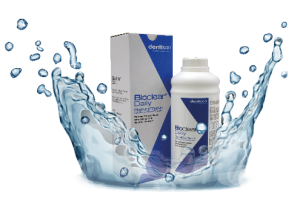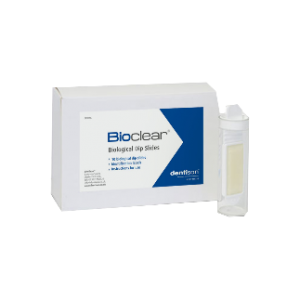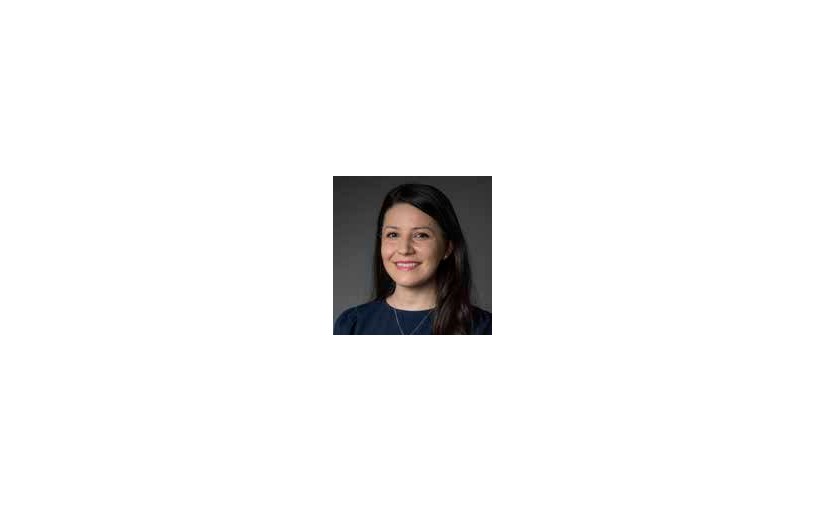DUWLs are an integral part of dental treatment centres, acting as both a coolant for instruments and handpieces and an irrigant during dental treatments. However, a range of studies looking specifically at DUWL water quality have evaluated the microbiological quality obtained from DUWL systems and indicate high levels of bacteria can be present in the water delivered from the unit into patients’ mouths[i]. For practices to remain compliant with NHMRC Australian Drinking Water Guidelines, the water entering a patient’s mouth for tooth irrigation during cavity preparation and for ultrasonic scaling should be no less than potable standard.
Similarly, according to the ADA Guidelines for Infection Control[ii], the number of bacteria in water used as a coolant or irrigant for non-surgical dental procedures should be less than 500 CFU/ml, the widely used international limit for safe drinking water[iii]. When treating immunocompromised patients, it is recommended that water from DUWLs contains less than 200 CFU/mL.
Most DUWLs contain biofilm, which acts as a reservoir of microbial contamination, causing water quality to be compromised. Waterlines must therefore be routinely cleaned, disinfected and monitored to ensure water quality is achieved and maintained.
What is Biofilm?
The term biofilm refers to a collection of microorganisms that adhere to a surface and are surrounded by a protective, sticky slime (known as the extracellular matrix), which is secreted by the bacteria.
Biofilms are particularly prevalent in water containing low concentrations of solids and low levels of nutrients. As well as DUWLs, biofilms can be found in streams and rivers, cooling towers, piped water systems and the U-bends of domestic sinks. 80-95% of bacteria in nature exist in biofilms and even the plaque that forms daily on teeth and which causes decay and gum disease, is a type of biofilm.
Biofilms form when a few individual bacteria in the planktonic state in water adhere to a solid surface such as the wall of a pipe or tube. Initially surface attraction is weak, but when subsequent bacteria continue to adhere directly to those already attached the adhesion is increased, allowing more planktonic bacteria to attach to the film, building up the level of biofilm which ultimately causes water quality to fall below recommended standards.
The Problem of Biofilms in DUWLs
Without treatment biofilm forms in DUWLs relatively quickly allowing microorganisms to multiply and disperse throughout the water system. DUWLs provide a nutrient-rich environment ideal for bacterial colonisation for a variety of reasons:
- The low flow rate of water in the narrow small bore tubes used in DUWLs – typically 30ml/min – encourages bacterial adhesion.
- The water flow is intermittent, causing minimal disruption to the growing biofilm and fresh liquid, such as when using a handpiece or the system is flushed, delivers more nutrients that encourages the growth of new biofilm.
- The materials used in DUWL tubing are non-toxic – and low toxicity to humans also means low toxicity to bacteria.
- A warm surgery environment provides an ideal temperature range for bacterial growth.
- Left untreated, the build-up of biofilm can damage surgery equipment by causing a reduction in water flow and even tube blockage, leading to surgery downtime and additional repair costs.
Protecting Patients and the Dental Team
Maintaining water quality is of considerable importance, primarily because both patients and the dental team are regularly exposed to water and aerosols generated by dental equipment. If biofilms are allowed to form in DUWLs, the pathogens settling on the internal wall of the tubing can then enter the oral cavity via high-speed handpieces, ultrasonic scalers, air/water syringes and mouth rinsing water, exposing patients and staff to microorganisms in fragments of biofilm that can cause illness.
Biofilm levels in dental equipment can be minimised by using a range of measures to remove, prevent and control biofilm formation and such measures will help maintain the recommended quality of dental water.
Purge
If a build-up of biofilm is identified, then purge cleaning should be carried out using a suitable Regulatory Compliance Marked biofilm remover. Bioclear is a pH neutral, odourless, ready-to-use solution that requires no mixing. Supplied in single-dose bottles (one bottle is one week’s treatment per chair), Bioclear is simply poured into the chair’s water bottle, drawn through so that it fills the water line and left for a minimum of 12 hours or over a weekend. Once the Bioclear treatment is complete, the line is simply flushed through with fresh water until the water runs clear.

Maintenance
Once a DUWL is free of contamination a product that can maintain low levels of biofilm is recommended. Bioclear Daily is a simple and easy-to-use solution which complies with ISO10993 for biocompatibility. Bioclear Daily is introduced directly into the dental unit water feed bottle as a solution in water, acting as a continuous method of controlling the amount of active bacteria in that water. Used daily, it reduces the planktonic bacteria count in water flowing through the unit, minimising the potential for biofilm formation. This solution is designed to prevent biofilm formation on an ongoing basis rather than removing existing biofilm from a system.

Monitoring
hichever type of biofilm control you undertake, it is important to regularly monitor the microbial contamination to ensure regulatory compliance. Biological dip slides are an ideal solution, which can be easily used in practice by simply wetting each side of the slide with the output water from each treatment centre. Once left for 72 hours, the dip slides will develop highly visual red spots where contamination is present allowing remedial action to be taken. If the DipSlide is clear that you can be confident that your water management system is working effectively. Regular monitoring of water quality is essential and DipSlide testing should be undertaken quarterly, for each treatment centre.

The problem of biofilm has long been an issue in dentistry. By controlling and eliminating the planktonic bacteria in DUWLs from the outset, biofilm simply cannot form, resulting in water that assures compliance with all regulatory guidelines and gives peace-of-mind for dentists who are ultimately responsible for the well-being of patients and staff.
[1] Walker JT, Bradshaw DJ, Bennett AM, Fulford MR, Martin MV, Marsh PD. Microbial Biofilm Formation and Contamination of Dental-Unit Water Systems in General Dental Practice. Applied and Environmental Microbiology. 2000; 66(8):3363-3367
[1] ADA Guidelines for Infection Control. Third Edition 2015.
[1] CDC (2003) Guidelines for Infection Control in Dental Health-Care Settings, page 29.
To order Dentisan Products, please visit www.henryschein.com.au or contact Henry Schein on 1300 65 88 22
QD-DS0241 Dentisan Bioclear Daily 1 litre
QD-DS025200 Dentisan Bioclear Kit 12 pack of 200ml bottles
QD-DS026 Dentisan Bioclear Dip Slides x 10 slides D-CLASS
QD-DS290 DentisanDentichlor Tablet x200 tblt water bottle disinfectant D-CLASS



Comments are closed.